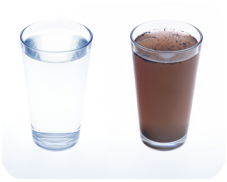Water Quality

Which of these glasses of water is cleaner?

It is easy to tell just by looking that the glass on the right is cleaner because it has less dirt and sand mixed in.

Now, which of these glasses of water is cleaner?

It is harder to tell just by looking when salt and chemicals are dissolved into the water.

Our world's water is a little bit like these glasses—some areas have clean, fresh water. Other areas have salty water, or water that is contaminated with chemicals, dirt and waste.

Fortunately, nature has a way to clean dirty water. It is called the water cycle. Water in lakes and streams evaporates into the air and leaves many pollutants behind. Eventually the water vapor condenses and falls to the ground as cleaner rainwater.

Water on the surface of the Earth is also filtered as it travels through the ground to underground aquifers, leaving behind many of the solid particles it carries.

Sometimes, microorganisms in the ground and in the water can further contribute to water purification by breaking down harmful contaminants.

Engineers use the Earth's natural processes as inspiration for creating their own water recycling systems. They use evaporation, filtration, desalination (a process of removing salt from water) and biological activity to create clean, safe drinking water.